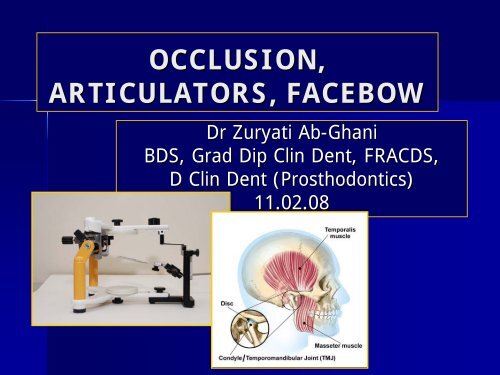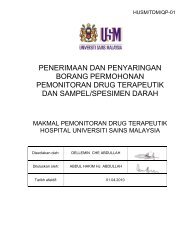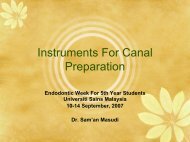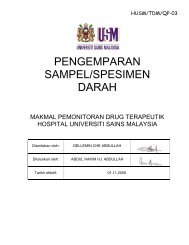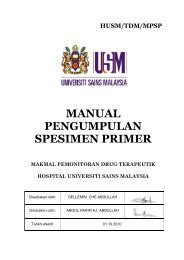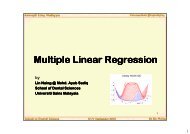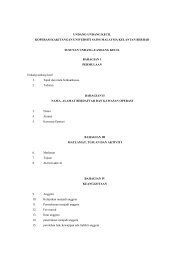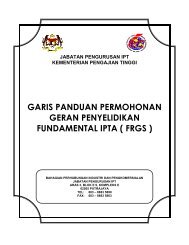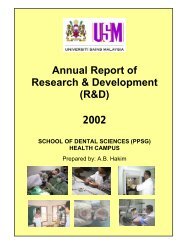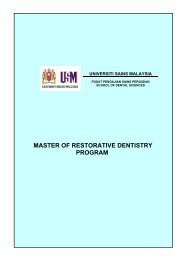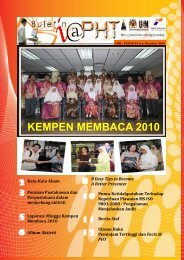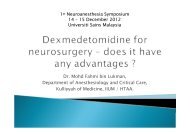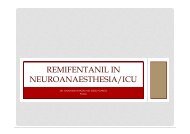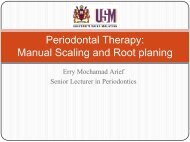OCCLUSION, ARTICULATORS, FACEBOW
OCCLUSION, ARTICULATORS, FACEBOW
OCCLUSION, ARTICULATORS, FACEBOW
Create successful ePaper yourself
Turn your PDF publications into a flip-book with our unique Google optimized e-Paper software.
<strong>OCCLUSION</strong>,<br />
<strong>ARTICULATORS</strong>, <strong>FACEBOW</strong><br />
Dr Zuryati Ab-Ghani<br />
BDS, Grad Dip Clin Dent, FRACDS,<br />
D Clin Dent (Prosthodontics(<br />
Prosthodontics)<br />
11.02.08
CONTENT<br />
• INTRODUCTION-<strong>OCCLUSION</strong><br />
<strong>OCCLUSION</strong><br />
• <strong>OCCLUSION</strong>-DEFINITIONS<br />
• POSSELT’S S BORDER MOVEMENTS<br />
• <strong>ARTICULATORS</strong> +<strong>FACEBOW</strong> RECORD
INTRODUCTION<br />
<strong>OCCLUSION</strong><br />
• Dynamic biological relaitonship of<br />
components of the masticatory system<br />
that control tooth contacts during<br />
function and dysfunction<br />
• It is the integrated action of the jaw<br />
muscles, TMJ and teeth
•www.myotronics.com<br />
<strong>OCCLUSION</strong>
Occlusion<br />
• Important to the provision of<br />
comprehensive patient care.<br />
• Relevant to all disciplines in dentistry<br />
• Restorative dentistry and prosthodontics:<br />
tooth restoration requires recognition of the<br />
importance of occlusal form and tooth<br />
contact patterns at an appropriate OVD, for<br />
optimizing jaw function
• An understanding of the importance of<br />
the occlusion is paramount for<br />
enhancing jaw function, defining lower<br />
face height and aesthetic needs, as<br />
key issues in optimizing oral health.
<strong>OCCLUSION</strong>-DEFINITIONS<br />
Intercuspal contact (IC)<br />
Contact between cusps, fossa, , marginal ridges of<br />
opposing teeth<br />
Intercuspal position (ICP)<br />
Position of the jaw when teeth are in IC<br />
Maximum intercuspation (MI)<br />
Contact of teeth with maximum clenching
Centric occlusion (CO)<br />
The tooth contact position when the jaw<br />
is in centric relation<br />
CO may or may not be the same tooth<br />
contact R/S as ICP<br />
Tooth contact (CO) when the jaw is in<br />
CR may be more retruded than at ICP
Retruded jaw position (RP)<br />
The position of the jaw when the<br />
condyles are in a physiologically<br />
acceptable guided position for the<br />
recording of transfer record<br />
Retruded contact position (RCP)<br />
The contact position of the teeth when<br />
the jaw is in RP
Centric relation (CR)<br />
The maxillomandibular relationship in which<br />
the condyles articulate with the thinnest<br />
avascular portion of their respective discs<br />
with the complex in the anterior-superior<br />
position against the slopes of the articular<br />
eminence.<br />
This position is independent of tooth contact
TMJ- Condyle at CR<br />
www.baileydds.com<br />
Iven Klineberg, , Rob Jagger, , 2004
Summary of definitions<br />
ICP, CR, RP<br />
IC, CO, RCP
Postural jaw position (PJP)<br />
Position of the jaw when an individual is<br />
sitting or standing upright when relaxed and<br />
alert<br />
A free way space or speaking space is present<br />
Occlusal vertical dimension (OVD)<br />
The vertical height of lower third of the face<br />
when teeth contact in ICP
Lateral jaw positions<br />
Non working/balancing<br />
The side of the jaw that moves towards midline<br />
The side opposite the chewing side<br />
Working side<br />
The side of the jaw that moves laterally<br />
away from the midline<br />
Chewing side (where the chewing occurs)<br />
• Canine guidance<br />
• Group function
Bennet movement: : The bodily lateral<br />
movement of the mandible resulting from<br />
the movements of the condyles along the<br />
lateral inclines along the mandibular fossa<br />
Bennet Angle: : Angle formed by movement of<br />
balancing condyle with sagittal plane during<br />
lateral jaw movement
POSSELT’S S BORDER<br />
MOVEMENT<br />
Posselt (1952) described the full range<br />
of jaw movement in 3 planes by<br />
tracing the path of lower incisor teeth<br />
as the jaw is guided through the<br />
border paths
POSSELT’S S BORDER MOVEMENTS<br />
Sagittal view<br />
Frontal view<br />
Horizontal view<br />
Iven Klineberg, , Rob Jagger, , 2004
<strong>ARTICULATORS</strong><br />
A hinged mechanical device to which<br />
maxillary and mandible casts are<br />
attached, to reproduce relationship of<br />
patient’s s maxilla to mandible in ICP<br />
and for lateral and protrusive jaw<br />
movements
Uses of articulators<br />
• Study the way teeth occlude for<br />
diagnosis and treatment planning<br />
• Allow formation of occlusal surfaces<br />
during lab preparation and adjustment<br />
of fixed and removable prostheses and<br />
indirect dental restorations
TYPES OF <strong>ARTICULATORS</strong><br />
• SIMPLE HINGE<br />
• AVERAGE VALUE (PLANE-LINE)<br />
LINE)<br />
• SEMI ADJUSTABLE<br />
• FULLY ADJUSTABLE
SIMPLE HINGE<br />
• Single hinge movement only<br />
• No lateral movement<br />
• Smaller than patient’s s jaws<br />
• Very limited value in restorative<br />
dentistry and prosthodontics but may<br />
allow preliminary evaluation of static<br />
tooth arrangement on study casts
SIMPLE HINGE
AVERAGE VALUE<br />
• Condylar angle fixed at 30°<br />
• No provision of adjustment for lateral<br />
mandibular shift<br />
• Adjustable incisal guidance<br />
• Considered sufficient for reproducing ICP on<br />
study casts<br />
• Produce an approximation of condylar<br />
movements and used to design and prepare<br />
complete dentures and simple restorations
AVERAGE VALUE (PLANE-LINE)<br />
LINE)
SEMI ADJUSTABLE<br />
• Allow adjustment of condylar inclination and<br />
Bennet angle<br />
• Intercondylar width fixed at 110mm<br />
• Condylar and Bennet angle are obtained<br />
from protrusive and lateral occlusal records<br />
or are set an average values<br />
• Incisal guidance are made by reference to<br />
the O/B and O/J of anterior teeth, or if the<br />
teeth are lost, an average value can be set.
SEMI ADJUSTABLE<br />
• Recommended for most dental<br />
restorations<br />
• More accurate than average value<br />
• Allows increase of OVD by raising the<br />
height of articulator pin<br />
• Arcon/non-arcon<br />
arcon: : the choice is<br />
operator preference
SEMI ADJUSTABLE<br />
Arcon<br />
• Fossa box in the upper<br />
member<br />
• Condylar sphere in the<br />
Lower member<br />
• Duplicates arrangement<br />
of TMJ<br />
Non–arcon<br />
• Condylar ball is attached<br />
to upper member<br />
• Slot mechanism attached<br />
to lower member
SEMI ADJUSTABLE-ARCON<br />
ARCON<br />
Stratos
SEMI ADJUSTABLE-NON<br />
ARCON<br />
Dentatus<br />
Condylar guidance<br />
Iven Klineberg, , Rob Jagger, , 2004
FULLY ADJUSTABLE<br />
• Complex<br />
• Designed to duplicate TMJ features<br />
• Condylar settings may be determined<br />
by pantograohic and stereographic<br />
records
FULLY ADJUSTABLE<br />
ARCON TYPE<br />
Iven Klineberg, , Rob Jagger, , 2004
<strong>FACEBOW</strong><br />
• An instrument that records the<br />
relationship of the maxilla to the hinge<br />
axis of rotation of the mandible<br />
• It allows the maxillary cast to be<br />
placed in an equivalent relationship on<br />
the articulator
<strong>FACEBOW</strong><br />
• In order to identify true hinge axis, hinge<br />
axis locator and hinge axis face bow are<br />
necessary<br />
• Facebows are commonly used with an<br />
arbitrary hinge axis that is located 13mm<br />
along a line drawn from the upper aspect of<br />
the superior border of the tragus of the ear<br />
to the outer canthus of the eye<br />
• Other arbitrary point of reference of the<br />
TMJ-external ear canal.
<strong>FACEBOW</strong><br />
• Allows transfer of intercondylar distance<br />
• In dentate patients, the facebow fork is<br />
used to locate the occlusal and incisal<br />
surfaces of the maxillary teeth. Wax<br />
impression compound attached to the fork<br />
must locate the tooth cusp<br />
• In edentulous patients, the fork is attached<br />
to a maxillary occlusal rim
<strong>FACEBOW</strong>
<strong>FACEBOW</strong><br />
• Iven Klineberg, , Rob Jagger.<br />
Iven Klineberg, , Rob Jagger, , 2004
Maxillary cast mounted using facebow record<br />
-Slidematic facebow with Denar articulator-<br />
Iven Klineberg, , Rob Jagger, , 2004
Summary<br />
• Remember and understand occlusion-<br />
definitions<br />
• Function and types of articulators<br />
• Function of a facebow
References<br />
• Occlusal and clinical practice. An Evidence-based<br />
approach. Iven Klineberg, , Rob Jagger. . Elsevier<br />
Limited, London, 2004<br />
• Textbook of Prosthodontics. . Deepak Nallaswamy.<br />
Jaypee brothers medical publishers (p) LTD. 2003<br />
• Management of Temporomandibular Disorders and<br />
Occlusion. Jeffrey P Okeson. . 5 th Edition, Mosby<br />
Inc., St Louis, 2003<br />
• www.uic.edu.com<br />
• www.myotronics.com<br />
• www.baileydds.com
THANK YOU


